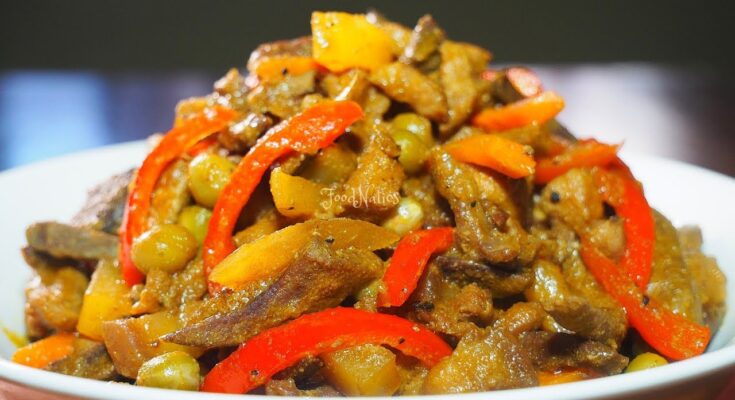Igado Recipe: There’s something deeply comforting about Filipino home cooking. It’s not just about flavors—it’s about memories. One dish that perfectly captures the essence of traditional Filipino flavors is Igado. If you’ve never heard of it before, Igado is a hearty and savory pork and liver stew, rooted in Ilocano cuisine in the northern Philippines. It combines bold spices, tender meat, vibrant vegetables, and that distinct punch of vinegar and soy sauce that Pinoy dishes are known for.
Think of it like the cousin of adobo—only this time, with pork liver stealing the spotlight. But don’t let the idea of liver intimidate you. Done right, it’s flavorful, velvety, and deeply satisfying. Whether you’re an experienced cook or just looking to try something new in the kitchen, this Igado recipe is your step-by-step guide to nailing the dish like a pro. Ready to take a culinary trip to the north of the Philippines? Let’s dive in.
Ingredients You’ll Need
The beauty of Igado lies in its simplicity and pantry-friendly ingredients. Here’s everything you’ll need to get started:
Main Ingredients
- 1/2 kg pork liver, cleaned and sliced thinly
- 1/2 kg pork tenderloin or pork shoulder, cut into strips
- 2 tbsp cooking oil
- 3 cloves garlic, minced
- 1 medium onion, chopped
- 1/3 cup soy sauce
- 1/4 cup vinegar
- 2 cups water or pork broth
Vegetables
- 1 small carrot, julienned
- 1 medium potato, diced
- 1/2 cup green peas (frozen or canned)
- 1 red bell pepper, sliced into strips
Condiments and Spices
- 2-3 bay leaves
- 1/2 tsp ground black pepper
- Salt to taste
Optional Add-ins
- 2-3 pieces hotdog, sliced diagonally
- A handful of raisins, for a subtle sweetness
- Green olives, for an extra tangy twist
These ingredients are flexible—you can add more vegetables or remove ones you don’t prefer. What matters most is balancing the liver, vinegar, and soy sauce to capture the soul of the dish.
Kitchen Tools You’ll Need
To make cooking smooth and hassle-free, here’s what you should have ready:
- A sharp knife and cutting board – for slicing meats and veggies precisely.
- Large skillet or wok – something deep enough to handle the saucy stew.
- Mixing bowls – for marinating and prepping your ingredients.
- Wooden spoon or spatula – perfect for sautéing without scratching your cookware.
- Measuring cups and spoons – to keep those proportions just right.
Preparing the Ingredients
Before you get to the fun part (cooking!), prepping your ingredients is key to ensuring a smooth cooking experience.
How to Clean and Slice Pork Liver
Liver is rich and tender, but can get chewy if not handled right. Here’s how:
- Rinse the liver under cold water.
- Pat it dry with paper towels.
- Slice it into thin, uniform strips, about 1/4 inch thick. Uniform slicing ensures even cooking.
- Optional: Soak in a bit of vinegar or calamansi juice for 10 minutes, then rinse again to reduce the “lansa” (gamey taste).
Slicing the Pork Tenderloin
- Slice against the grain into thin strips. This keeps the meat tender and easy to chew.
- You can also use pork belly or kasim (shoulder) if you prefer fattier meat.
Vegetable Prep
- Peel and dice the potato and carrot uniformly.
- Cut bell peppers into strips for color and sweetness.
- If using canned peas, drain them first. Frozen peas? No problem—just add them in during cooking.
Marinate the Pork
- Combine pork slices with 1 tbsp soy sauce, a pinch of pepper, and 1 crushed garlic clove.
- Let it sit for 15–30 minutes for deeper flavor. Trust me, it makes a difference.
Step-by-Step Cooking Instructions
Now that everything’s prepped, it’s time to cook this savory masterpiece.
Step 1: Sauté Aromatics
Heat oil in a pan over medium heat. Sauté chopped onions and minced garlic until soft and aromatic. This builds the savory base that Igado is known for.
Step 2: Add and Cook Pork Tenderloin
Add sliced pork tenderloin and cook until lightly browned. Stir occasionally to ensure even cooking. Browning the pork enhances its flavor and helps create a richer dish.
Step 3: Add Pork Liver and Stir-Fry Briefly
Add sliced pork liver and stir-fry for 1–2 minutes. Do not overcook the liver—it will continue cooking later. Keeping it tender is key to good Igado.
Step 4: Pour in Soy Sauce and Vinegar (Without Stirring)
Add soy sauce and vinegar directly into the pan, but do not stir yet. Let the vinegar boil uncovered for a minute to reduce its strong acidity.
Step 5: Simmer with Bay Leaves and Pepper
Add bay leaves and crushed black pepper. Stir gently and allow the mixture to simmer for 15–20 minutes until the meat becomes tender and the flavors deepen.
Step 6: Add Vegetables and Continue Cooking
Add carrots, bell peppers, and green peas. Cook until the vegetables are tender but still vibrant, adding a splash of water if needed.
Step 7: Optional Ingredients for Extra Flavor
You may add raisins for sweetness, chili for heat, or potatoes for extra heartiness. These variations add personality to your Igado.
Step 8: Taste, Adjust, and Simmer Till Cooked Through
Taste the sauce and adjust with more soy sauce, pepper, or vinegar. Simmer for a few more minutes until everything blends well.
Serve hot with steamed rice. Enjoy your rich, savory Igado!
Tips for Cooking Perfect Igado
Cooking Igado isn’t rocket science, but there are a few tips that make all the difference between a decent dish and a “wow-this-is-so-good” kind of meal.
1. Use Fresh Pork Liver
Fresh liver has a milder taste and better texture. Avoid frozen or old liver—it tends to be rubbery and gamey. Always clean and slice it thinly for best results.
2. Perfect the Vinegar-to-Soy Sauce Ratio
This ratio can make or break your Igado. A good starting point is 1 part vinegar to 1.5 parts soy sauce. Some prefer a tangier finish—others want a more umami-forward dish. Find your balance.
3. Don’t Stir the Vinegar Immediately
When vinegar hits the pan, resist the urge to stir! Letting it simmer undisturbed allows the sharpness to cook off, giving the dish that mellow, signature sourness.
4. Mind the Cooking Time for Liver
Liver cooks fast—3 to 5 minutes is all it needs. Add it after the pork starts to brown, and don’t let it simmer too long. Overcooked liver is tough and grainy.
5. Don’t Overcrowd the Pan
If your pan’s too crowded, the pork will steam instead of sear. Cook in batches if needed to get that delicious golden crust on the meat.
6. Taste As You Go
This can’t be stressed enough. With soy sauce and vinegar being bold flavors, it’s crucial to taste and tweak during cooking.
Common Mistakes to Avoid
Even experienced cooks can mess up Igado if they aren’t careful. Watch out for these common pitfalls:
Stirring Vinegar Too Soon
As mentioned, this is one of the golden rules. Stirring vinegar before it has time to cook changes the dish’s flavor drastically. The result? A sour, harsh taste instead of that mellow tang.
Overcooking the Liver
Overdone liver turns crumbly and chalky. Cook it just until it changes color—no more than 5 minutes.
Using Low-Quality Soy Sauce
This is a soy sauce-forward dish. Invest in a good brand of Filipino soy sauce (like Silver Swan or Datu Puti) for authentic flavor.
Skipping Marination
Marinating pork in soy sauce and garlic before cooking helps tenderize it and boosts the flavor. Even 15 minutes makes a difference.
Using Too Many Add-ins
Hotdogs, olives, raisins—they’re fun, but don’t overdo it. Keep the focus on the pork and liver.
Serving Suggestions
Igado is typically served as a main dish during lunch or dinner, often accompanied by other Filipino favorites. Here’s how to elevate your Igado meal:
Best Served With:
- Steamed white rice – A must! The sauce soaks into the rice, making every bite irresistible.
- Garlic fried rice (sinangag) – For an even bolder pairing, especially at breakfast.
- Pandesal or crusty bread – For mopping up that savory sauce.
Great Side Dish Pairings:
- Ensaladang Mangga – The tanginess of green mango salad complements the rich flavors.
- Tortang Talong (Eggplant Omelet) – A soft, smoky contrast to the bold Igado.
- Fresh cucumber salad – Adds a refreshing crunch and balances the savory profile.
Drinks That Go Well:
- Calamansi juice – Refreshing and light
- Cold soda – For a classic Pinoy combo
- San Miguel Beer – If you’re feeling like having a more festive meal
Storage and Reheating Tips
Igado is one of those dishes that tastes even better the next day, after the flavors have melded together. Here’s how to store it properly:
Refrigeration:
- Let the dish cool completely before transferring it to an airtight container.
- Store in the fridge for up to 3 to 4 days.
- When reheating, use a saucepan over low heat or microwave for 2–3 minutes, stirring halfway.
Freezing:
- Igado freezes well! Place it in freezer-safe containers and store for up to 1 month.
- Thaw overnight in the fridge before reheating.
- Reheat on the stove with a splash of water to bring back the sauce.
Meal Prep Tip:
- Store in single-serve containers for grab-and-go lunches.
- Pair with pre-cooked rice and a vegetable side for a complete meal.
Nutritional Value of Igado
Igado isn’t just delicious—it also brings a ton of nutritional value to your plate, especially when made with fresh ingredients and served with healthy sides.
High in Protein
- Both pork tenderloin and pork liver are excellent sources of protein, essential for muscle repair and immune function.
- A single serving of Igado can provide up to 25–30 grams of protein, depending on the portion size.
Rich in Vitamins and Minerals
- Pork liver is one of the most nutrient-dense organ meats. It’s high in:
- Vitamin A – good for vision, skin, and immune health
- Iron – helps prevent anemia
- Vitamin B12 – supports nerve function
- Zinc – helps with wound healing and immunity
Vegetables Add Fiber and Micronutrients
- Carrots, peas, and bell peppers boost the fiber content, making the dish more satisfying and beneficial for digestion.
- These vegetables also bring antioxidants and natural sugars that balance the rich meat flavors.
Mind the Sodium and Cholesterol
- With soy sauce as a base and pork liver involved, Igado can be high in sodium and cholesterol.
- People with hypertension or heart issues should enjoy in moderation or adjust the recipe with low-sodium soy sauce and less liver.
Overall, Igado can be a nutritious part of a balanced diet when eaten mindfully and paired with lots of veggies and whole grains.
Regional Variations of Igado
Although Igado is most famously associated with Ilocano cuisine, you’ll find that the dish takes on many forms depending on where it’s made and who’s cooking it. Here’s a look at how it varies across different parts of the Philippines:
Ilocano Igado (Traditional Style)
- Minimalist and bold – Uses pork liver, lean pork, soy sauce, vinegar, and minimal vegetables.
- Sour-forward – Vinegar is more prominent.
- Usually doesn’t include tomato sauce or hotdogs.
Tagalog-Style Igado
- Incorporates tomato sauce, making it a bit sweeter and more stew-like.
- Often includes carrots, bell peppers, and peas.
- Slightly more saucy and colorful than the Ilocano version.
Modern Twists
- Some households add boiled quail eggs, green olives, or even pineapple chunks.
- In creative versions, the dish is made entirely with chicken liver or with tofu for a vegetarian adaptation.
The great thing about Igado is that it’s adaptable. You can follow a traditional route or tweak it based on your family’s taste or what you have in the fridge. Either way, you’ll still end up with a comforting, flavor-packed dish.
Make-Ahead and Meal Prep Ideas
Igado isn’t just a crowd-pleaser—it’s also a meal-prepper’s dream. Here’s how to incorporate it into your weekly rotation:
Batch Cooking Tips
- Double the recipe and divide into multiple containers for the week.
- Keeps well in the fridge for up to 4 days and can be frozen for longer storage.
Pairing for Balanced Meals
- Combine with brown rice, quinoa, or cauliflower rice for added fiber and nutrients.
- Add steamed vegetables on the side for a complete, healthy plate.
Quick Reheating
- Igado reheats quickly, making it perfect for busy workday lunches or lazy dinners.
- Just reheat on the stovetop or in the microwave and you’re good to go.
Make Once, Serve Twice
- Serve hot and saucy the first time.
- For leftovers, you can also stir-fry the Igado with day-old rice to create an Igado fried rice—super flavorful and satisfying.
Why You Should Try Cooking Igado at Home
Still on the fence about making Igado yourself? Here’s why it’s absolutely worth a shot:
It’s Budget-Friendly
- Pork liver and pork shoulder are affordable cuts of meat.
- The vegetables and pantry staples are easy to find and inexpensive.
It’s Packed with Flavor
- The savory-sour balance is addictive.
- The mix of liver, soy sauce, vinegar, and aromatics creates a taste that’s bold yet comforting.
It’s Culturally Rich
- Cooking Igado is like bringing a piece of Ilocano heritage into your kitchen.
- It’s a dish passed down through generations, and making it connects you to the roots of Filipino cuisine.
It’s Perfect for Sharing
- One pot of Igado can feed an entire family.
- It’s ideal for potlucks, family dinners, and Sunday lunches.
So, the next time you’re craving something hearty, homey, and undeniably Pinoy—cook up a batch of Igado. You won’t regret it.
FAQs about Igado Recipe
1. Can I use chicken liver instead of pork liver?
Yes, you can! Chicken liver has a softer texture and milder flavor. Just make sure to cook it for less time—about 2 to 3 minutes—to avoid it getting mushy.
2. How long can I store cooked Igado in the fridge?
Igado can be safely stored in an airtight container in the fridge for 3 to 4 days. For longer storage, freeze it for up to a month.
3. What’s the best vinegar to use for Igado?
Traditional cane vinegar (like Datu Puti) is best for authentic flavor. However, you can also use white vinegar or apple cider vinegar in a pinch—just adjust the amount to taste.
4. Can I make this dish spicy?
Absolutely! Add chopped siling labuyo (bird’s eye chili) or a pinch of chili flakes while sautéing the garlic and onion to give the dish a spicy kick.
5. Is Igado considered a healthy dish?
Igado is nutrient-rich, especially in iron and protein. However, it can also be high in cholesterol due to the liver, so enjoy in moderation if you’re watching your cholesterol levels.
Conclusion
Igado might not be as universally known as adobo or sinigang, but once you’ve tried it, it’s hard not to fall in love. With its rich, tangy, and savory flavor, tender meat, and colorful medley of vegetables, it’s one of those dishes that hits the spot every time.
Whether you’re making it the traditional Ilocano way or adding your own spin with hotdogs and raisins, Igado is forgiving, flavorful, and full of character. It’s a dish that brings people together, warms your belly, and reminds you why Filipino food is so beloved around the world.
Give this Igado recipe a try—you might just find your new favorite comfort food.



